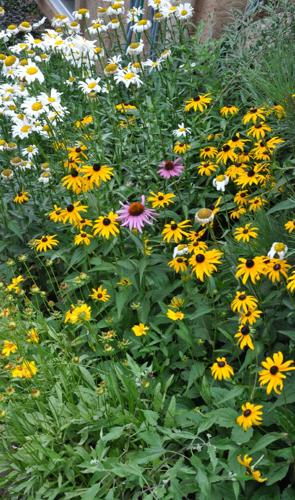Year-round gardening: Take time to divide perennial plants
Starting in mid-July and through the fall is a time of the year when even the most inexperienced gardener can practice vegetative propagation of new plants from existing plants. For most gardeners, it is sheer joy to turn a thriving plant that you love into several new plants to thrive and love! Plant division can feel like magic.
The signs that a plant may benefit from division include:
• Overcrowding.
• Reduced flowering or smaller foliage.
• The center of the plant is not growing, a bald spot.
There are some general timing guidelines that are helpful:
• Divide after bloom is complete, at least four weeks before frost.
• Plants that bloom in spring, in general, should be divided in late summer to fall; this gives the root system time to establish before winter
• Fall blooming plants should be divided in the spring; they will have the next growing season to establish and prepare to bloom again.
Before getting your shovel out, identify the plant you want to divide.
• Research how to divide that particular plant. An internet search is often an easy way to find out how to divide. Try to find the information on Cooperative Extension resources (website address will end in .edu) or other reliable source.
• Some plants will not transplant or divide well. For example, butterfly weed (Asclepias tuberosa) relies on a deep tap root and will not transplant well
Division can be as simple as digging up the plant and gently pulling sections of the plants roots system apart; for denser root systems you may need a clean set of clippers or pruners to cleanly divide the root system. Iris feature very dense rhizomes and will require a tool to separate the sections.
Once you have done the research and have your tools ready:
• Choose a cool, cloudy day if possible.
• Make sure the plants are well watered both before digging up and after transplant.
• If the plants do wilt and die back, leave them in place for a few weeks. If the plants were healthy, there is a good chance you will see new growth a week or two later.
• Make sure your tools are clean and sharp. Dig up the plant with a sharp shovel, getting as much root as possible. Move the shovel around the plant, gently prying up until the plant can easily be lifted out of the hole.
• Gently remove excess soil and divide the plant into divisions that include healthy roots and several leaves. Discard any diseased or damaged segments.
• Replant the divisions where desired. Water regularly during establishment but do not overwater; the root systems may rot if overwatered.
A few plants that are recommended for late summer/autumn division:
• Iris.
• Peony.
• Coneflowers.
• Bee Balm.
• Black-eyed Susan.
• Lung orts (Pulmonaria).
• Salvia.
Submit gardening questions to csumg2@elpasoco.com or call 719-520-7684. The in-person help desk is open 9 a.m.-noon and 1-4 p.m. Mondays, Wednesdays and Thursdays. Visit elpaso.extension.colostate.edu and register for upcoming classes at epcextension.eventbrite.com.
Submit gardening questions to csumg2@elpasoco.com or call 719-520-7684. The in-person help desk is open 9 a.m.-noon and 1-4 p.m. Mondays, Wednesdays and Thursdays. Visit elpaso.extension.colostate.edu and register for upcoming classes at epcextension.eventbrite.com.





